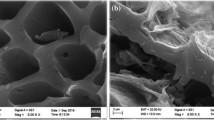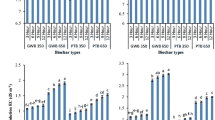Abstract
Pyrolysis is the foremost thermal conversion process that can be successfully used to transform biomaterials into a value-added product. The estimated biodegradable portion is prominent and denotes as 60% from total waste generation in Asian developing countries. There have been several studies on exploring the pyrolysis of complex organic fraction of municipal solid waste (MSW) streams as a sustainable MSW management technique. The objective of this research was to evaluate physicochemical characteristics of MSW biochar (MSW-BC) produced from organic MSW to observe its potential for landfill contaminant removal with case studies from Sri Lanka. Biochar was pyrolyzed from the MSW in an onsite pyrolyzer. For physicochemical properties of biochar, pH, point of zero charge, electrical conductivity, proximate analysis, ultimate analysis, heavy metal composition, bioavailable heavy metal composition and BET surface area were acquired. In addition, surface functional groups and structural identification were determined by FTIR analysis and scanning electron microscopy (SEM) analysis, respectively. Adsorption capacities for the pollutants (benzene and toluene) were examined by batch sorption experiments. Furthermore, sorption isotherms were fitted using non-linear models for better understanding of the sorption capacities of the materials. Ultimate analysis data suggested high-temperature pyrolysis of MSW. Further, low values for both H/C and polarity index depict the strongly carbonized and highly aromatic structure in BC. Additionally, FTIR suggested a loss of labile, aliphatic compounds and functional groups during pyrolysis and the formation of more recalcitrant, aromatic constituents, whereas BET and SEM data revealed a well-developed porous structure and surface properties, which indicates MSW-BC to be a potential sorbent. Further, the reported total and bioavailable heavy metal content was low in MSW-BC; hence, it can be easily mixed with compost and used as a fertilizer. At the same time, MSW-BC will potentially be used to remediate heavy metals in the landfill leachate. Therefore, MSW-BC shows high potential to be used as a material to remediate contaminants simultaneously that minimizes MSW volume. Thus, conversion of MSW to BC and chemical and thermal modification of MSW-BC would allow effective engineering to optimize their properties as a potential material in landfill covers and permeable reactive barriers and integrate in leachate treatment techniques.
Access this chapter
Tax calculation will be finalised at checkout
Purchases are for personal use only
Similar content being viewed by others
References
Agarwal M, Tardio J, Mohan SV (2015) Pyrolysis biochar from cellulosic municipal solid waste as adsorbent for azo dye removal: equilibrium isotherms and kinetics analysis. Int J Environ Sci Dev 6:67
Agrafioti E, Kalderis D, Diamadopoulos E (2014) Arsenic and chromium removal from water using biochars derived from rice husk, organic solid wastes and sewage sludge. J Environ Manag 133:309–314
Ateş F, Miskolczi N, Borsodi N (2013) Comparison of real waste (MSW and MPW) pyrolysis in batch reactor over different catalysts. Part I: product yields, gas and pyrolysis oil properties. Bioresour Technol 133:443–454
Barrett A, Lawlor J (1995) The economics of solid waste management in Ireland, Economic and Social Research Institute (ESRI)
Bernardo M, Lapa N, Gonçalves M, Mendes B, Pinto F, Fonseca I, Lopes H (2012) Physico-chemical properties of chars obtained in the co-pyrolysis of waste mixtures. J Hazard Mater 219:196–202
Bornemann LC, Kookana RS, Welp G (2007) Differential sorption behaviour of aromatic hydrocarbons on charcoals prepared at different temperatures from grass and wood. Chemosphere 67:1033–1042
Buah W, Cunliffe A, Williams P (2007) Characterization of products from the pyrolysis of municipal solid waste. Process Saf Environ Prot 85:450–457
Chen T, Zhang Y, Wang H, Lu W, Zhou Z, Zhang Y, Ren L (2014) Influence of pyrolysis temperature on characteristics and heavy metal adsorptive performance of biochar derived from municipal sewage sludge. Bioresour Technol 164:47–54
Enders A, Hanley K, Whitman T, Joseph S, Lehmann J (2012) Characterization of biochars to evaluate recalcitrance and agronomic performance. Bioresour Technol 114:644–653
Essandoh M, Kunwar B, Pittman CU, Mohan D, Mlsna T (2015) Sorptive removal of salicylic acid and ibuprofen from aqueous solutions using pine wood fast pyrolysis biochar. Chem Eng J 265:219–227
Fagbemi L, Khezami L, Capart R (2001) Pyrolysis products from different biomasses: application to the thermal cracking of tar. Appl Energy 69:293–306
He M, Xiao B, Liu S, Hu Z, Guo X, Luo S, Yang F (2010) Syngas production from pyrolysis of municipal solid waste (MSW) with dolomite as downstream catalysts. J Anal Appl Pyrolysis 87:181–187
Jin H, Capareda S, Chang Z, Gao J, Xu Y, Zhang J (2014) Biochar pyrolytically produced from municipal solid wastes for aqueous as (V) removal: adsorption property and its improvement with KOH activation. Bioresour Technol 169:622–629
Kabir MJ, Chowdhury AA, Rasul MG (2015) Pyrolysis of municipal green waste: a modelling, simulation and experimental analysis. Energies 8:7522–7541
Li G, Shen B, Wang Y, Yue S, Xi Y, An M, Ren K (2015) Comparative study of element mercury removal by three bio-chars from various solid wastes. Fuel 145:189–195
Liu T, Liu B, Zhang W (2014a) Nutrients and heavy metals in biochar produced by sewage sludge pyrolysis: Its application in soil amendment. Polish J Environ Stud 23:271–276
Liu T, Liu B, Zhang W (2014b) Nutrients and heavy metals in biochar produced by sewage sludge pyrolysis: its application in soil amendment. Pol J Environ Stud 23:271–275
Liu G, Xie M, Zhang S (2015) Effect of organic fraction of municipal solid waste (OFMSW)-based biochar on organic carbon mineralization in a dry land soil. J Mater Cycles Waste Manag 1–10
Malkow T (2004) Novel and innovative pyrolysis and gasification technologies for energy efficient and environmentally sound MSW disposal. Waste Manag 24:53–79
Mukherjee A, Zimmerman A, Harris W (2011) Surface chemistry variations among a series of laboratory-produced biochars. Geoderma 163:247–255
Omri A, Benzina M, Trabelsi W, Ammar N (2014) Adsorptive removal of humic acid on activated carbon prepared from almond shell: approach for the treatment of industrial phosphoric acid solution. Desalin Water Treat 52:2241–2252
Onyango D (2014) Pyrolysis: an alternative technology for municipal solid waste management. Scientific conference proceedings
Phan AN, Ryu C, Sharifi VN, Swithenbank J (2008) Characterisation of slow pyrolysis products from segregated wastes for energy production. J Anal Appl Pyrolysis 81:65–71
Roy G (1988) Municipal solid waste recycle-an economic proposition for a developing nation
Sadasivam BY, Reddy KR (2015) Adsorption and transport of methane in landfill cover soil amended with waste-wood biochars. J Environ Manag 158:11–23
Serio MA, Kroo E, Bassilakis R, Wójtowicz MA, Suuberg EM (2001) A prototype pyrolyzer for solid waste resource recovery in space. SAE Technical Paper
Sharypov V, Marin N, Beregovtsova N, Baryshnikov S, Kuznetsov B, Cebolla V, Weber J (2002) Co-pyrolysis of wood biomass and synthetic polymer mixtures. Part I: influence of experimental conditions on the evolution of solids, liquids and gases. J Anal Appl Pyrolysis 64:15–28
Sørum L, Grønli MG, Hustad JE (2001) Pyrolysis characteristics and kinetics of municipal solid wastes. Fuel 80:1217–1227
Van Zwieten L, Kimber S, Morris S, Chan K, Downie A, Rust J, Joseph S, Cowie A (2010) Effects of biochar from slow pyrolysis of papermill waste on agronomic performance and soil fertility. Plant Soil 327:235–246
Velghe I, Carleer R, Yperman J, Schreurs S (2011) Study of the pyrolysis of municipal solid waste for the production of valuable products. J Anal Appl Pyrolysis 92:366–375
Venderbosch R, Prins W (2010) Fast pyrolysis technology development. Biofuels Bioprod Biorefin 4:178
Yang H, Yan R, Chen H, Lee DH, Zheng C (2007) Characteristics of hemicellulose, cellulose and lignin pyrolysis. Fuel 86:1781–1788
Yuan H, Wang Y, Kobayashi N, Zhao D, Xing S (2015) Study of fuel properties of torrefied municipal solid waste. Energy Fuel 29:4976–4980
Zai-Ming C, Bao-Liang C, Dan-Dan Z (2013) Composition and sorption properties of rice-straw derived biochars. Acta Sci Circumst 33:9–19
Zhang J, Liu J, Liu R (2015) Effects of pyrolysis temperature and heating time on biochar obtained from the pyrolysis of straw and lignosulfonate. Bioresour Technology 176:288–291
Zhou H, Long Y, Meng A, Li Q, Zhang Y (2013) The pyrolysis simulation of five biomass species by hemi-cellulose, cellulose and lignin based on thermogravimetric curves. Thermochim Acta 566:36–43
Zornoza R, Moreno-Barriga F, Acosta J, Muñoz M, Faz A (2016) Stability, nutrient availability and hydrophobicity of biochars derived from manure, crop residues, and municipal solid waste for their use as soil amendments. Chemosphere 144:122–130
Acknowledgements
Equipment and financial supports from the JICA-JST SATREPS grant and NRC 15-24 are gratefully acknowledged.
Author information
Authors and Affiliations
Corresponding author
Editor information
Editors and Affiliations
Rights and permissions
Copyright information
© 2018 Springer Nature Singapore Pte Ltd.
About this paper
Cite this paper
Jayawardhana, Y., Kumarathilaka, P., Mayakaduwa, S., Weerasundara, L., Bandara, T., Vithanage, M. (2018). Characteristics of Municipal Solid Waste Biochar: Its Potential to be Used in Environmental Remediation. In: Ghosh, S. (eds) Utilization and Management of Bioresources. Springer, Singapore. https://doi.org/10.1007/978-981-10-5349-8_20
Download citation
DOI: https://doi.org/10.1007/978-981-10-5349-8_20
Published:
Publisher Name: Springer, Singapore
Print ISBN: 978-981-10-5348-1
Online ISBN: 978-981-10-5349-8
eBook Packages: Earth and Environmental ScienceEarth and Environmental Science (R0)




